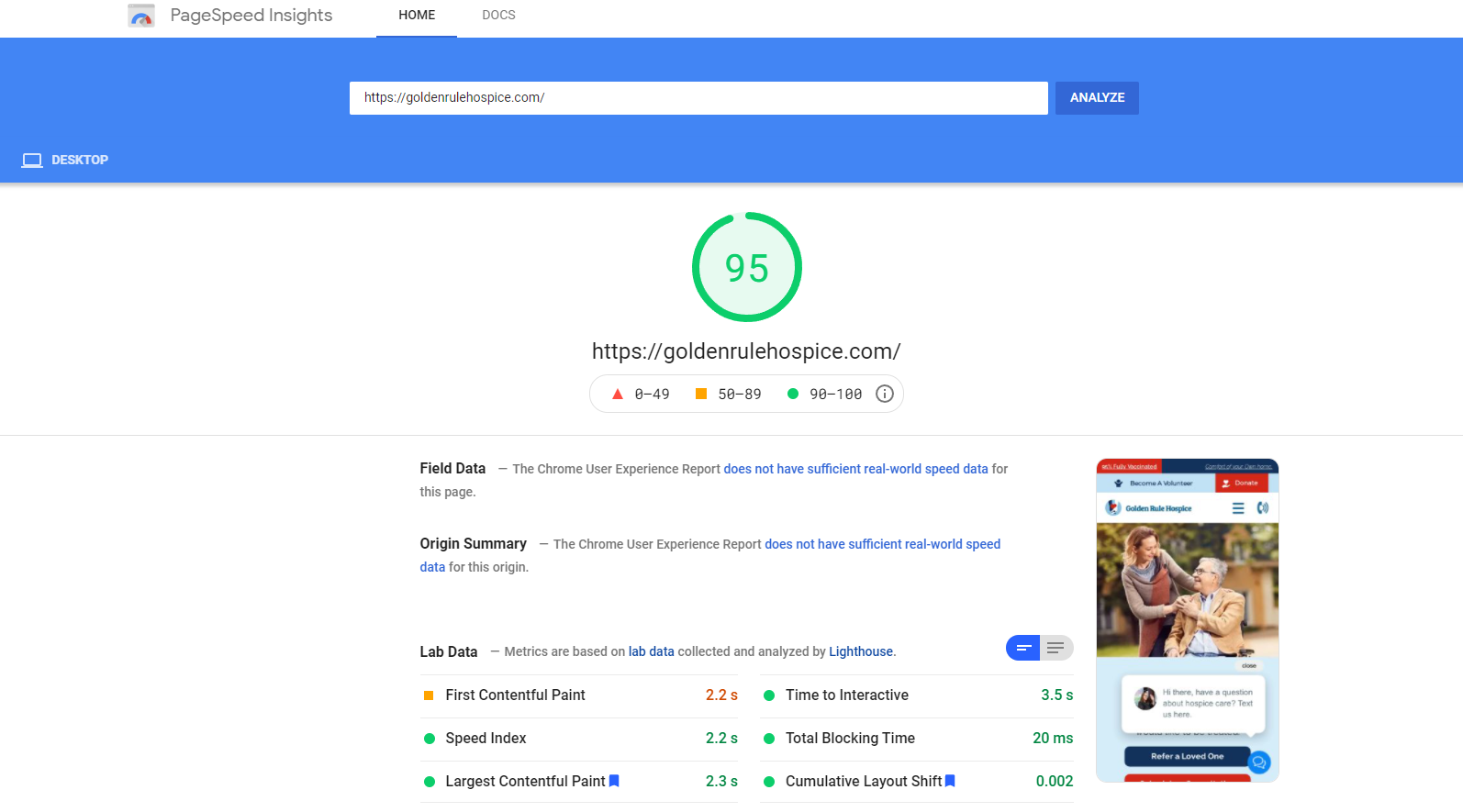In 2021, a consistent trend we’ve seen is healthcare organizations investing in their digital presence. Not surprisingly, a new or updated website is usually a top priority. It’s your hub, welcome mat, traffic generator, and more. What we tell clients is that design and fancy functionality are just part of the puzzle. It’s not enough to have a good-looking website.
And it’s a critical error to leave search engine optimization (SEO) until the end or as an afterthought.
Trust us on this one. If you’re a healthcare organization considering a new website now or in 2022, make sure to put in foundational SEO as soon as possible. This is the surest way to rank for the keywords that generate more high-quality leads in the long run.
7 Essential Principles for Optimizing Your Website for Search
That said, website SEO is a broad topic with lots of nuances. To help clarify what we mean by “putting foundational SEO in place,” think of your website as a plot of land. If you’re going to develop that land, build houses and condos on it, you’ll need to map out the best layout for optimal land use; you’ll need to plan for plumbing, electrical, HVAC, etc., in a way that allows for now-construction and future expansion. And so on.
It’s a crude example, but it illustrates the point well. A website’s SEO will depend on its structure, site architecture, and URL hierarchy—foundational SEO that ensures that you can rank for target keywords and can scale your website with growth in the future. As such, your website should follow these seven principles of site architecture:
1. Organized
Not so long ago, we published a new webinar entitled “SEO Audit on the 3 Pillars of Successful SEO Strategies,” with John McAlpin, our terrific SEO Director. Here’s what John had to say about how site organization feeds into technical SEO:
“Technical SEO is the foundation of all SEO, content is the meat, and link building is the cherry on top. All three of them work hand in hand to help accelerate your organic performance.”
The recipe for foundational technical SEO has a few ingredients. As you organize your own site, remember that every piece of content has a place. Typically, that content is organized under your main navigation (main menu). That main menu should tell a story that gives website visitors exactly what they will get at a glance.
That menu is an outward representation of the way you structure and organize your site pages. You’ll want to group page types so they’re easy to navigate wherever a person is on the site. Typically, these groupings are hierarchical (your parent “Services” page might have subpages for specific service categories, for example).

As a general rule, keep page groupings and site structure as simple as possible for easier navigation and site crawlability. And make sure to write distinct meta descriptions, titles, tags, and heading tags for each of these pages (another key ingredient of technical SEO and overall site organization).
2. Discoverable
There are a couple of aspects of discoverability to consider. First of all, what good is your big, beautiful services page, or new blog post, if a visitor to your website can’t find it? “You don’t want your users going five clicks deep just to find key information,” says John McAlpin in 6 SEO Principles That Make It Easy for Healthcare Consumers to Find You.
So, the first question you need to address from a discoverability standpoint is, can people get to your most important pages in three clicks or fewer, no matter their entry point?
Another aspect of discoverability is from the search engine standpoint. Can Google and other search engines discover, find, and crawl all of your site’s pages? One key step you can take is to add the Sitemap & Robots.txt file. Robots.txt and sitemap.xml are essential files that can help search engines better understand your particular website and index it correctly. For this reason, robots.txt and XML sitemaps go hand in hand.
3. Unique
Okay, your site is organized and discoverable. Now it’s time to address user experience (UX) and design, which can help your site in several ways. “This is where UX and design come into play,” says John McAlpin. “You don’t want to look like all your competitors. You want to have something that stands out as memorable.”
Unique websites originate from a clear sense of identity. Focus on who you are and who you help. This should inform your messaging, aesthetic, voice, tone, and other things that will make you unique. No duplicate content! Make sure to trim down duplicate content and create redirects where needed. If your website doesn’t feel unique, you’re probably not communicating what you do effectively.
Perhaps that’s something your team needs to revisit and formalize.
4. Linkable
People link to other websites when they want to point readers to an authoritative source. Likewise, people will link to your website when they feel that they’ve found reliable information that brings value to their own audience. “Make sure you have natural linking opportunities within your website, and you have content worth linking to through your link-building campaigns,” says John McAlpin.
You’ll want to approach linkability from a few different angles:
- Build out excellent content that brings value to your audience. Do your pages have the authoritative information that people want to link to from their own sites?
- Evaluate pages with no internal links and a few external links. Add internal links to pages that are missing them and remove external links from service pages.
- Launch link building campaigns to expand your backlink portfolio. The more that authoritative websites link back to your own, the better your site’s SEO.
5. Consistent
You want continuity in terms of theme, structure, and page types throughout all sites of a given brand (or brands). Consistency ensures that your website looks coherent and works harmoniously across all its different elements, such as headers, footers, sidebars, and navigation bars.
It also:
- Gives your users a more recognizable and memorable experience
- Enables users to carry out tasks more quickly and efficiently
- Improves usability and learnability of your website
- Eliminates pain points and difficult navigation
- Saves money and time on design
“Make sure that your content is consistent. Consistent branding, consistent messaging, and consistent theme.”
6. Valuable
We mentioned the importance of bringing value in the linkability section above. Bringing value has broader SEO benefits for your site. “The number one rule is to make sure every page delivers some value. Get rid of all those pages that aren’t delivering value for you,” recommends John McAlpin.
So, do your site visitors get something from your site (instead of only being sold something?). Value might be:
- Educational content that helps them make an informed decision about their healthcare
- Price and insurance information that helps them evaluate costs
- Testimonials and case studies
- New research and reporting on important medical topics
Of course, there are other ways to add value to your pages. You can put content in a format that follows UX best practices, for one. When you optimize current pages for a better UX, you can not only reduce bounce rates, but help users read the content better. Certain page formats, such as adding headers and bullet points to break up pages, can also help you rank for featured snippets.
As you revisit existing services pages and blog posts, look for opportunities to take certain topics deeper to bring more value to people and search engines. As always, make sure you’re targeting the right audience and keywords.
7. Fast
The Page Experience update from Google has made it essential for websites to be optimized for speed and mobile. There are a LOT of ways to make your site faster. Fundamentally, you’ll want to set up your website from the beginning to maximize page speed. When determining your site structure, for example, evaluate the technical and hosting foundation (these are more difficult to address later on).

Here are some common speed-killers for websites:
- WYSIWYG themes
- Poor hosting
- Too many third-party scripts
- Too many plugins
- No or inadequate caching
- Unoptimized images
Our tips for creating faster websites? Start by “clearing out the weeds,” so to speak. Audit and clean up your Google Tag Manager (GTM) and other third-party scripts. Update what plugins you do have, remove the unnecessary ones, and disable your current site speed plugins. And optimize the format, file size, load order of your images!
With that low-hanging fruit out of the way, here are a few more technical site-speed optimizations:
- Revisit your heatmap tracking, a common culprit
- Check to see if your PHP is out of date
- Setup a content delivery network (CDN)
In the End, Your Site is Only As Good as Its SEO
It’s true. While the seven principles outlined here happen to be SEO-related, they really affect all aspects of your website. Attention to these seven essential principles will help healthcare consumers trying to find a great provider. It will help you build credibility and trust with healthcare consumers, affiliates, partners, and so on. It will let patients know that they can trust you and your site, while improving the overall experience with your brand.
Indeed, a strong SEO foundation has major benefits for websites that can lead to long-term exponential growth. This is why we’re encouraging all of our healthcare clients to make both SEO and web strategy a core part of their digital marketing strategies.

